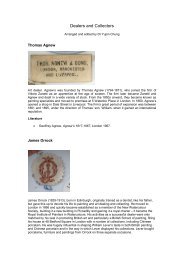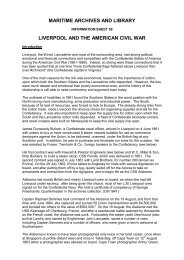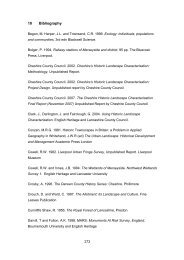Shabti Figure (pdf) - National Museums Liverpool
Shabti Figure (pdf) - National Museums Liverpool
Shabti Figure (pdf) - National Museums Liverpool
Create successful ePaper yourself
Turn your PDF publications into a flip-book with our unique Google optimized e-Paper software.
Lesson Plan<br />
Year Group: Y3-Y6 Subject: Literacy/History Topic: Objects used in tombs for use in the afterlife (shabti)<br />
Learning Objective: I can describe the role of a shabti in the afterlife<br />
Outcome/Purpose: A performance to show Osiris that you will work hard! Audience: Osiris<br />
Curriculum links:<br />
HISTORY:<br />
Historical interpretation:<br />
3. Pupils should be taught to recognise that the past is<br />
represented and interpreted in different ways, and to give<br />
reasons for this.<br />
Historical enquiry:<br />
4. Pupils should be taught how to find out about the events,<br />
people and changes studied from an appropriate range of<br />
sources of information, including ICT-based resources.<br />
ART AND DESIGN<br />
Knowledge and understanding<br />
4b. Materials and processes used in art, craft and design and<br />
how these can be matched to ideas and intentions.<br />
4c. The roles and purposes of artists, craftspeople and<br />
designers working in different times and cultures.<br />
Curriculum links:<br />
LITERACY<br />
En 1 Speaking and Listening<br />
Speaking<br />
1a. Use vocabulary and syntax that enables them to<br />
communicate more complex meanings.<br />
b. Gain and maintain the interest and response of different<br />
audiences [for example, by exaggeration, humour, varying pace<br />
and using persuasive language to achieve particular effects].<br />
Drama<br />
4a. Create, adapt and sustain different roles, individually and in<br />
groups.<br />
b. Use character, action and narrative to convey story, themes,<br />
emotions, ideas in plays they devise and script.<br />
Breadth of study<br />
5d. Investigating art, craft and design in the locality and in a<br />
variety of genres, styles and traditions.<br />
Artefact: shabti figure<br />
Artefact notes:<br />
It is called a ‘shabti’, which is the ancient Egyptian word for ‘answerer’. The figurine ‘answered’ when<br />
the dead person called for it to do chores in the afterlife (once its owner had made a difficult journey,<br />
was guided to the judgement hall by Anubis, had his heart weighed and been judged by Osiris). Ancient<br />
Egyptians expected to do work for Osiris, the ruler in the afterlife. They could reduce their chores by<br />
having substitutes to work for them. <strong>Shabti</strong> figures were placed in tombs so that they could come to life<br />
through magic and work for Osiris on behalf of their owner. The most common work was farming in the<br />
fields of the afterlife. <strong>Shabti</strong> figures began to be placed in tombs from around 2000 BC and continued to be<br />
popular until the Romans conquered Egypt 2000 years later.
Lesson Plan<br />
Year Group: Y3-Y6 Subject: Literacy/History Topic: Objects used in tombs for use in the afterlife (shabti)<br />
Learning Objective: I can describe the role of a shabti in the afterlife<br />
Outcome/Purpose: A performance to show Osiris that you will work hard! Audience: Osiris<br />
Teaching/Learning:<br />
1. Talk through ‘vocabulary/glossary’<br />
shabti, chore, Anubis, Osiris, afterlife, plough, shaduf, sickle, threshing, chaff<br />
2. Investigate the <strong>Shabti</strong> artefact:<br />
What does it look like<br />
What does it feel like<br />
How was it made<br />
What was it made for<br />
Is it well designed<br />
3. Read through explanation (see ‘Artefact notes’ overleaf)<br />
Task:<br />
Imagine that you are a shabti. You have<br />
entered into the afterlife and you have<br />
been instructed by your owner to work in<br />
Osiris’s fields as a farmer (which is just<br />
like working in the fields of ancient Egypt).<br />
Create a series of movements with words<br />
to show Osiris all the different chores you<br />
are required to do in the course of a year.<br />
Look at the pictures about ancient<br />
Egyptian farming and the text to help you.<br />
Success Criteria:<br />
*Perform at least 3<br />
chores in the right order<br />
*Use your whole body<br />
to show each chore<br />
*Use technical words<br />
(E.g. plough, sickle,<br />
shaduf)<br />
*Use time connectives<br />
(E.g. firstly, then, next,<br />
after that, finally)<br />
Differentiation:<br />
Less able:<br />
Imagine the chores that your owner might ask you to<br />
do for Osiris as an afterlife shabti in today’s world. For<br />
example:<br />
*the tasks in school (e.g. sharpening pencils, collecting<br />
books, filling water bottles).<br />
*the tasks at home (e.g. washing up, tidying your room,<br />
buying bread and milk from the shop).<br />
More able:<br />
Provide a limit to the number of words in the email to<br />
encourage prioritising the importance of information.<br />
Plenary:<br />
Share the performances<br />
with the class (acting as<br />
Osiris!).<br />
*What chores can you<br />
recall<br />
*How did they use the<br />
body to show each chore<br />
*How did they use<br />
technical words<br />
*Did they use time<br />
connectives<br />
Vocabulary/Glossary:<br />
shabti: figurine called ‘answerer’.<br />
chore: everyday task or job.<br />
Anubis: Egyptian god who protected the cemetery and guided the dead to judgement, usually shown as<br />
a jackal or a man with a jackal head.<br />
Osiris: Egyptian god who ruled the Afterlife and judged the dead.<br />
afterlife: the life ancient Egyptians expected after death.<br />
plough: a pointed tool used to break up dirt.<br />
shaduf: a machine to move water from one place to another.<br />
sickle: a tool with a curved blade used to cut plant stalks.<br />
threshing: separating the seeds of wheat or barley from their stalks.<br />
chaff: coverings (husks) of seeds of wheat and barley you can’t eat.<br />
Possible follow up activities:<br />
LITERACY: Write a series of diary entry for your shabti about their experiences in the afterlife.<br />
ART AND DESIGN: Design your own shabti for our times. What chores would your shabti do What tools will they need to help them with<br />
their chores<br />
CITIZENSHIP: Discuss the items or objects that you like to have with you when you are frightened/when you do something new/ when you<br />
go on holiday.


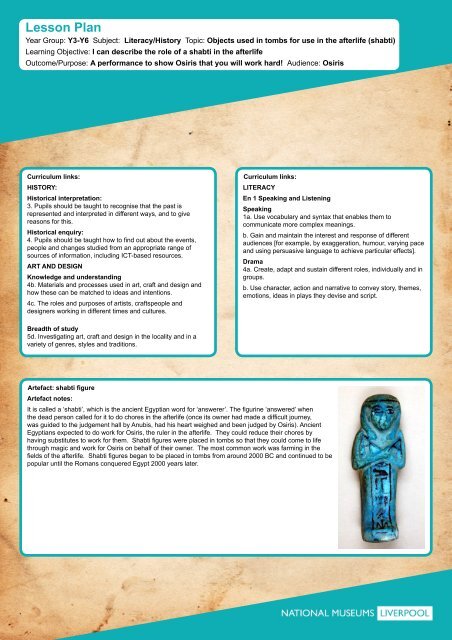
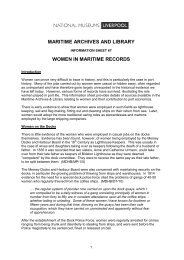
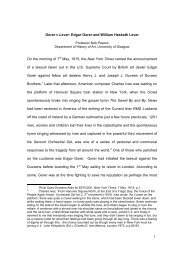

![Ancient Egypt trail [227kb .pdf] - National Museums Liverpool](https://img.yumpu.com/48998817/1/184x260/ancient-egypt-trail-227kb-pdf-national-museums-liverpool.jpg?quality=85)

